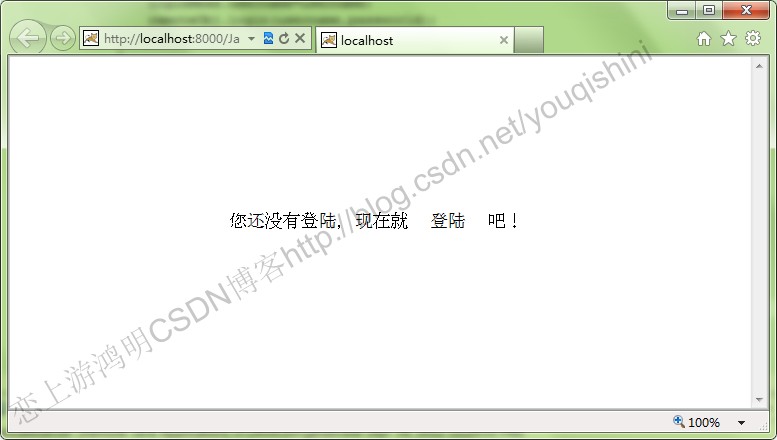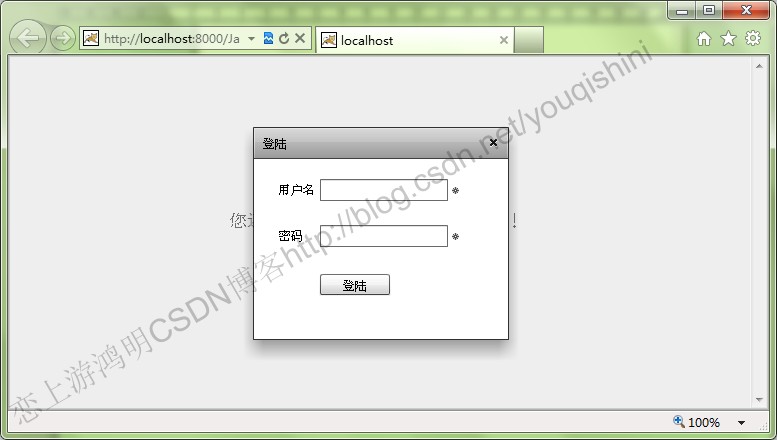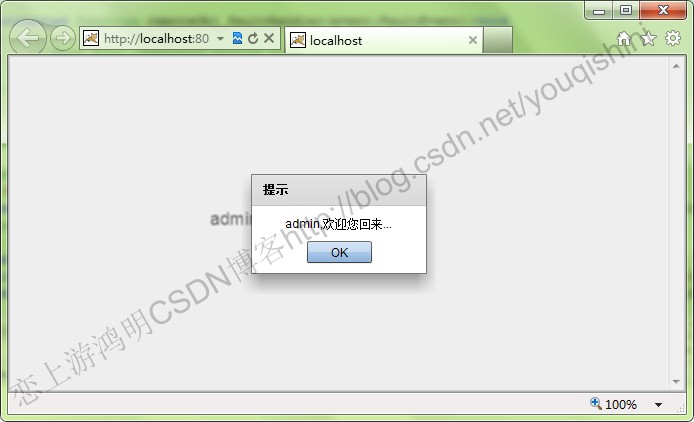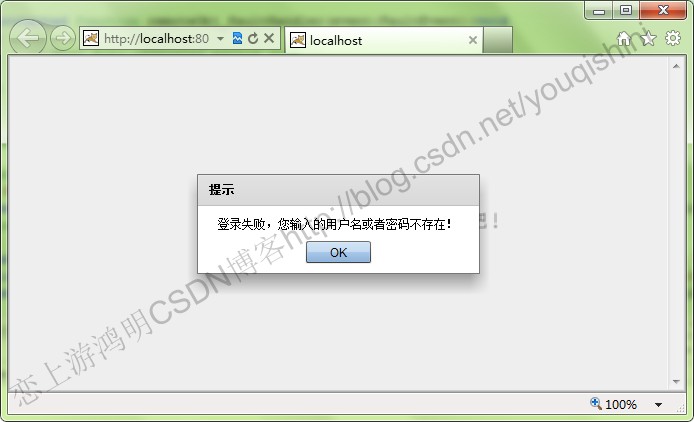Flex用RemoteObject方式与Java通信是最常用的方式,这是一种最直观的方式。当然Flex也可以用HttpService与服务器类如servlet通信,这也是本次学习的重点。
这次学习是在上节的基础上进行的。本节学习用到的LoginEvent.as,LoginModule.sa文件代码如上节所示。
好了,新建一个servlet类LoginServlet.java,代码如下所示:
|
1
2
3
4
5
6
7
8
9
10
11
12
13
14
15
16
17
18
19
20
21
22
23
24
25
26
27
|
package com.it161.servlet;import java.io.IOException;import java.io.PrintWriter; import javax.servlet.ServletException;import javax.servlet.http.HttpServlet;import javax.servlet.http.HttpServletRequest;import javax.servlet.http.HttpServletResponse; publicclass LoginServlet extends HttpServlet { @Override protectedvoid service(HttpServletRequest req, HttpServletResponse resp) throws ServletException, IOException { // TODO Auto-generatedmethod stub req.setCharacterEncoding("utf-8"); resp.setCharacterEncoding("utf-8"); PrintWriter out=resp.getWriter(); String username=req.getParameter("username"); String passworld=req.getParameter("passworld"); //System.out.println(username+":"+passworld); if(username.equals("admin")&&passworld.equals("123")){ out.print(true); }else{ out.print(false); } }} |
这个servlet在web.xml中的配置如下所示:
|
1
2
3
4
5
6
7
8
|
<servlet> <servlet-name>LoginServlet</servlet-name> <servlet-class>com.yqsn.servlet.LoginServlet</servlet-class> </servlet><servlet-mapping> <servlet-name>LoginServlet</servlet-name> <url-pattern>/LoginServlet</url-pattern> </servlet-mapping> |
将MyEclipse切换到flash视图,新建一个application文件HttpServiceDemo.mxml,代码如下所示:
|
1
2
3
4
5
6
7
8
9
10
11
12
13
14
15
16
17
18
19
20
21
22
23
24
25
26
27
28
29
30
31
32
33
34
35
36
37
38
39
40
41
42
43
44
45
46
47
48
49
50
51
52
53
54
55
56
57
58
59
60
61
62
63
64
65
66
67
68
69
70
71
72
73
|
<?xmlversion="1.0" encoding="utf-8"?> <fx:Script> <![CDATA[ import com.flex.ases.LoginEvent; import com.flex.ases.LoginMess; import com.flex.module.LoginModule; import mx.controls.Alert; import mx.managers.PopUpManager; import mx.rpc.events.FaultEvent; import mx.rpc.events.ResultEvent; privatevar loginModule:LoginModule=new LoginModule(); [Bindable] private var username:String; [Bindable] private varpassworld:String; protectedfunction login_clickHandler(event:MouseEvent):void { // TODOAuto-generated method stub PopUpManager.addPopUp(loginModule,this,true); PopUpManager.centerPopUp(this.loginModule); loginModule.addEventListener(LoginEvent.LOGIN_EVENT,loginHander); } publicfunction loginHander(event:LoginEvent):void{ //varobj:Object=event.loginMess as Object; username=event.loginMess['username']; passworld=event.loginMess['passworld']; httpServiceSend.send(); } protectedfunction httpServiceSend_faultHandler(event:FaultEvent):void { // TODOAuto-generated method stub Alert.show(event.fault.message as String,"提示"); } protectedfunction httpServiceSend_resultHandler(event:ResultEvent):void { // TODOAuto-generated method stub var result:Boolean=event.result as Boolean; if(result==true){ Alert.show(username+",欢迎您回来!","提示"); aaa.text=username+",欢迎您回来!"; login.label=""; bbb.text=""; }else{ Alert.show("对不起,用户名或密码不存在!","提示"); } //Alert.show("成功了!"); } ]]> </fx:Script> <fx:Declarations> <!-- Place non-visualelements (e.g., services, value objects) here --> <s:HTTPService id="httpServiceSend" url="http://localhost:8000/JavaAndFlexDemo/LoginServlet" useProxy="false"fault="httpServiceSend_faultHandler(event)"result="httpServiceSend_resultHandler(event)" > <s:request> <username>{username}</username> <passworld>{passworld}</passworld> </s:request> </s:HTTPService> </fx:Declarations> <s:Label x="200" y="150" width="182" height="27" fontSize="18" id="aaa" text="您还没有登陆,现在就" verticalAlign="middle"/> <mx:LinkButton x="393" y="150" width="57" height="27" label="登陆" id="login" fontSize="18"click="login_clickHandler(event)"/> <s:Label x="459" y="150" width="37" height="27" id="bbb" fontSize="18" text="吧!" verticalAlign="middle"/></s:Application> |
从代码中我们可以看出,我们先定义一个HttpServlet发送请求httpServiceSend,然后通过下面这种方式存值:
|
1
2
3
4
|
<s:request > <username>{username}</username> <passworld>{passworld}</passworld> </s:request> |
这种方式很简单,我们在后台通过request. getParameter(“参数名”)取值就可以了,当然我们也可以在loginHander(event:LoginEvent)函数中通过下面方式存值并发送请求:
|
1
2
3
4
5
6
7
8
9
|
public functionloginHander(event:LoginEvent):void{ //varobj:Object=event.loginMess as Object; username=event.loginMess['username']; passworld=event.loginMess['passworld']; var obj:Object=new Object; obj.username=username; obj.passworld=passworld; httpServiceSend.send(obj); } |
运行结果是一样的,你可以试试。
好了,程序算是完成了,现在开始验收结果。
打开服务器并部署项目,运行felx页面RemoteObjectDemo.mxml,如下所示:

当我们点击“登陆”按钮后,弹出module页面,如下所示:

当我们输入的用户名和密码都正确时则提示你登陆正确:

输入错误则提示你输入不正确:

可以看出,我们输入的用户名与密码已经用httpservice方式发送到后台并且成功接受了并将结果返回给前台了。
好了,就学习这么多,下节将学习WebService方式。
原创文章,转载请注明出处:http://www.it161.com/article/webDetail?articleid=140111230433
更多原创内容,请访问:http://www.it161.com/